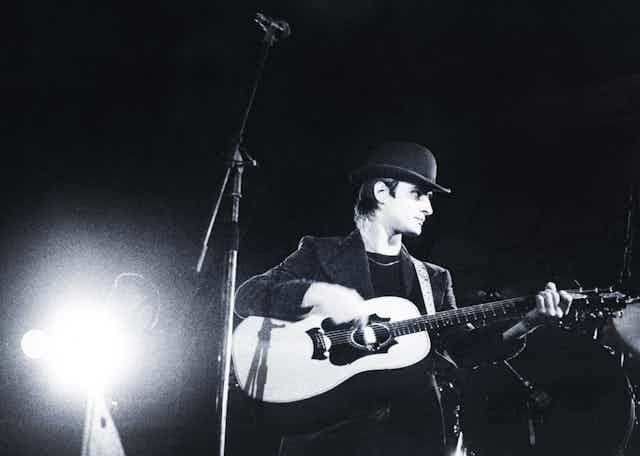Musician Steve Harley’s death last week came as a shock to me. After four months analysing his music and visual performances for my doctoral thesis on British glam rock, I’d come to feel like I somehow knew him.
The feeling was compounded by the fact Harley had answered some questions for me some years earlier and wished me well in my studies. To me, then, he was a nice, approachable person, generous with his time. He was also a unique and innovative musician, beginning with albums The Human Menagerie (1973) and The Psychomodo (1974), whose influence has extended well beyond the 1970s.
But Harley has received much less scholarly attention than his glam-rock-era peers. David Bowie, in particular, has (rightfully) been the subject of books, symposiums and university courses. And scholars around the world have analysed glam rock itself in its various forms and incarnations.
Harley, however, is notably absent from these discussions. One reason is that glam-rock scholarship is still growing, with much still to do. Another reason may be that Harley is not as easily categorised as other glam-rock musicians.
While many were androgynous, for instance, Harley was relatively understated. Musically, too, Steve Harley & Cockney Rebel broke the rock ‘n’ roll mould, opting for an electric violin instead of electric guitars.
Without the electric guitar, there was room for Harley to perform with a certain theatricality, both vocally and as reflected in the band’s often lush instrumentation. In 1974’s Tumbling Down, Harley laments what’s been done to the blues, accompanied by a full choir, orchestra and sentimental flourishes.
Musical melodrama
While glam-era Bowie was theatrical in a stagey, physical sense – the Ziggy Stardust live concerts being the prime example – Harley’s theatricality was different. He drew from Berlin cabaret, among other such influences, but went beyond that, offering shimmering, shivering musical melodrama that departed from the usual glam-rock formulas.
While glam band The Sweet were campy in a comedic way, Steve Harley’s camp lay in his fin de siècle, dramatic excess. Imagine the orchestral flourish of Bowie’s Life On Mars? (1971), but filtered through a candlelit, absinthe-driven night in Paris.
Read more: David Bowie: pop star who fell to earth to teach outsiders they can be heroes
Even his more upbeat tracks – Sweet Dreams (1974) or Psychomodo (1974), for example – embody a quirky angularity that recalls the visual style of a German Expressionist film.
At the same time, such songs anticipated the vocal styles of later art-rock, punk and new-wave singers. Harley’s sense of camp can also be found in his key influences: Busby Berkeley musicals and Marlene Dietrich.
Filmmaker Todd Haynes insightfully layered Harley’s musical melodrama into the more decadently theatrical moments of his 1998 glam-rock film Velvet Goldmine. Actor Jonathan Rhys Meyers performs Tumbling Down in blue-green body paint and pastel feather boa on an elaborate staircase and, finally, on top of an ornate chandelier.
Make Me Smile
Harley is most remembered, of course, for the 1975 hit Make Me Smile (Come Up And See Me), his most upbeat, conventionally “pop” single. Its welcoming acoustic guitar strum and catchy melody – replete with “ooh la la la la” backing vocals – has been covered more than 100 times, notably as the B-side to Duran Duran’s The Reflex in 1984.
Cheerful, charming and representative of Harley’s poppier sensibilities, Make Me Smile is also an exception. It departs from the often dark elegance of The Human Menagerie or The Psychomodo albums, and from the off-kilter circus-cabaret of his other glam-era pop single Mr. Soft (1974).
Read more: Kiss’s debut album at 50: how the rock legends went from 'clowns' to becoming immortalised
Like the other “serious” glam rockers of the era – such as Roxy Music’s Brian Eno – Harley didn’t really think of himself as a glam-rock artist. Nevertheless, he’s considered a key figure in “high glam” – the artier type, embodied by David Bowie and early Roxy Music.
High glam required a sort of intellectualism, and an intellectual distance from the broader glam-rock genre. It was a world away from Slade’s Cum On Feel The Noize or The Sweet’s party-rock stompers. Its cerebral artiness – including its denial of being glam rock at all – was what defined it.

Once and future glam
British glam rock met the end of its cycle in the mid-1970s. Bowie moved on, Eno left Roxy Music, and The Sweet broke up with their songwriters to become the hard-rock band they always wanted to be.
Like Bowie, Harley endured – releasing new music and touring regularly. Glam rock has both morphed and echoed throughout the decades, emerging in new wave, glam metal and Britpop’s more glamorous, Bowie-influenced artists (Suede, Pulp). Most recently, glam has resurfaced in decadent Italian rockers Måneskin.
Until late last year, Harley had planned to tour. He cancelled on receiving a cancer diagnosis, and his death was swift. Along with Bowie, Marc Bolan and most of the original members of The Sweet, Steve Harley has joined that growing pantheon of glam-era musicians who are no longer with us.
With Make Me Smile (Come Up And See Me) now played in his honour, we should also remember him as a key and innovative figure in a pivotal rock era.

